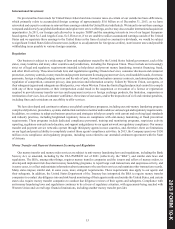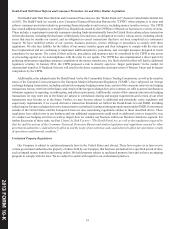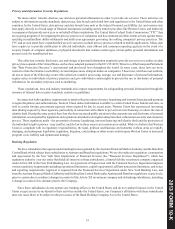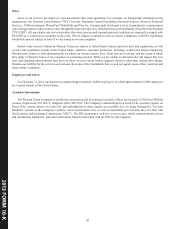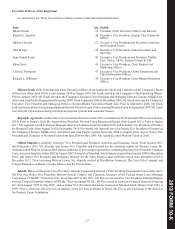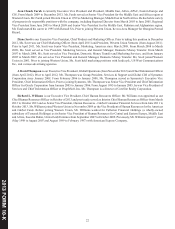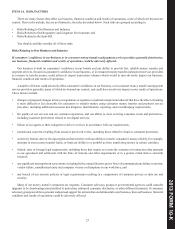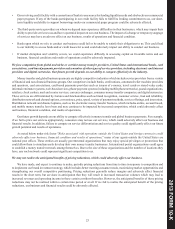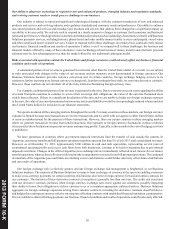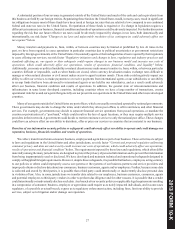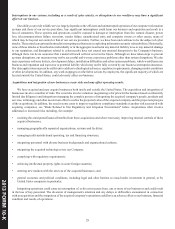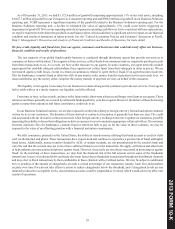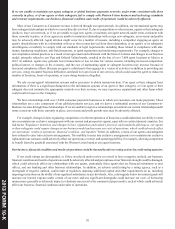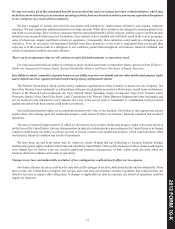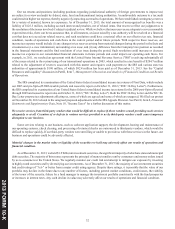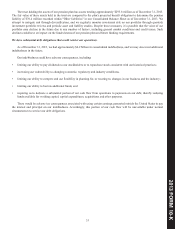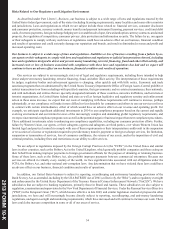Western Union 2013 Annual Report Download - page 135
Download and view the complete annual report
Please find page 135 of the 2013 Western Union annual report below. You can navigate through the pages in the report by either clicking on the pages listed below, or by using the keyword search tool below to find specific information within the annual report.
2013 FORM 10-K
•
•
•
•
•
•
•
•
•
25
• Our revolving credit facility with a consortium of banks is one source for funding liquidity needs and also backs our commercial
paper program. If any of the banks participating in our credit facility fails to fulfill its lending commitment to us, our short-
term liquidity and ability to support borrowings under our commercial paper program could be adversely affected.
• The third-party service providers on whom we depend may experience difficulties in their businesses, which may impair their
ability to provide services to us and have a potential impact on our own business. The impact of a change or temporary stoppage
of services may have an adverse effect on our business, results of operations and financial condition.
• Banks upon which we rely to conduct our business could fail or be unable to satisfy their obligations to us. This could lead
to our inability to access funds and/or credit losses for us and could adversely impact our ability to conduct our business.
• If market disruption and volatility occurs, we could experience difficulty in accessing capital on favorable terms and our
business, financial condition and results of operations could be adversely impacted.
We face competition from global and niche or corridor money transfer providers, United States and international banks, card
associations, card-based payments providers and a number of other types of service providers, including electronic and Internet
providers and digital currencies. Our future growth depends on our ability to compete effectively in the industry.
Money transfer and global business payments are highly competitive industries which include service providers from a variety
of financial and non-financial business groups. Our competitors include banks, credit unions, automated teller machine providers
and operators, card associations, card-based payments providers such as issuers of e-money, travel cards or stored-value cards,
informal remittance systems, web-based services, phone payment systems (including mobile phone networks), postal organizations,
retailers, check cashers, mail and courier services, currency exchanges, consumer money transfer companies, and digital currencies.
These services are differentiated by features and functionalities such as brand recognition, customer service, trust and reliability,
distribution network and channel options, convenience, price, speed, variety of payment methods, service offerings, and innovation.
Distribution network and channel options, such as the electronic money transfer business, which includes online, account based,
and mobile money transfer, have been and may continue to be impacted by increased competition, which could adversely affect
our business, financial condition, and results of operations.
Our future growth depends on our ability to compete effectively in money transfer and global business payments. For example,
if we fail to price our services appropriately, consumers may not use our services, which could adversely affect our business and
financial results. In addition, failure to compete on service differentiation and service quality could significantly affect our future
growth potential and results of operations.
As noted below under risk factor "Risks associated with operations outside the United States and foreign currencies could
adversely affect our business, financial condition and results of operations," many of our agents outside the United States are
national post offices. These entities are usually governmental organizations that may enjoy special privileges or protections that
could allow them to simultaneously develop their own money transfer businesses. International postal organizations could agree
to establish a money transfer network among themselves. Due to the size of these organizations and the number of locations they
have, any such network could represent significant competition to us.
We may not realize the anticipated benefits of pricing reductions, which could adversely affect our business.
We have made, and expect to continue to make, periodic pricing reductions from time to time in response to competition and
to implement our brand investment strategy, which includes better meeting consumer needs, maximizing market opportunities and
strengthening our overall competitive positioning. Pricing reductions generally reduce margins and adversely affect financial
results in the short term, but are done in anticipation that they will result in increased transaction volumes which may lead to
increased revenues and operating income in these certain corridors thereafter. However, the anticipated benefits of these pricing
reductions may not be realized within a certain time period or at all. If we fail to realize the anticipated benefit of the pricing
reductions, our business and financial results could be adversely affected.


